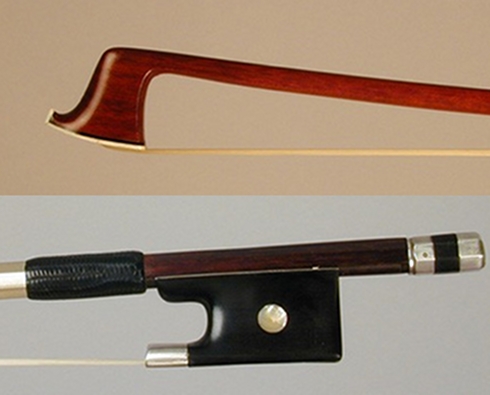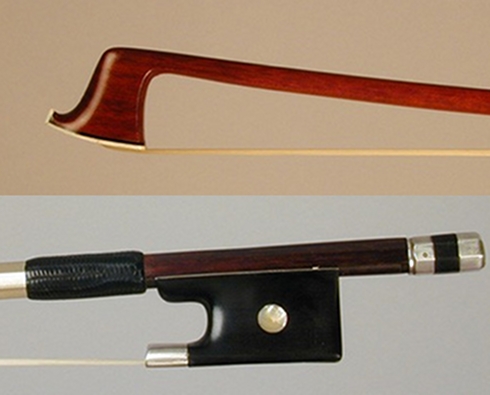J.J. MARTIN: THE LAST GREAT ONE
At first I had thought to title the blog as : J.J. Martin, the poor visionary. Quite fitting title for a part of his life. Both statements are true, it was very poor and even visionary, even if they are not sufficient to describe the work of this last Great one .

Violin bow Jean Joseph Martin ca. 1870
He was born on February 16, 1837 in Mirecourt by Louis Martin, who occasionally worked in the world of violin making, a temporary worked for that period and Marie Cunisset embroiderer. As you may recall the town of Mirecourt was famous for laces, in addition to bows and violins.
He looses his father at an early age and is forced to start his apprentice when he is very young. His luck as a bowmaker lies in the choice of where to make his apprenticeship. He starts working by Nicolas Maline, you may recall that, even if he never went to Paris, he was started to the job by Etienne Pajeot and when he was only eighteen had started working for J.B. Vuillaume.
Having started with Maline, was very important for this craftsman, it gave him the opportunity to learn the techniques and mechanics of the old school, that one of Dominique Peccatte, so to speak.
For this reason when he is twenty-one years, Martin, blind in one eye (as reported on the passport that was necessary to leave Mirecourt and reach Paris), he comes to Vuillaume, he refuses to be ensnared by the charm of the new, developed by Voirin in the same years.
A story that makes us understand the conditions of life of this man. When he went to Paris in 1858, he is so poor, that he is forced to walk for 365 km separating Mirecourt from the capital, taking more than ten days!
In Vuillaume's laboratory, apart meeting Voirin, he also finds a friend / colleague of his Master Maline: Nicolas Maire, who after the death of Pajeot in '53-'54, moved to Paris in those years and just started to work for Vuillame . It is exactly the contact with these two Great that he will definitely shape his technique, partially screened from the wind of the new school.
Back to Mirecourt in '63 he marries Rose Mougenot on August 28 of that year. This union is very important, because she is coming from a family of well-known bowmakers, so Joseph was able to begin his own business counting on a good commercial support.
At least for the first time business is good. After 1870, he declares to employ some some workers and to produce 144 bows a month.
In 1875, we have the first signs of his visionary mood. Not taking into account the selfishness and protagonism-mania of ninety-seven percent of the craftsmen, he tries to create the first corporation. A "union of artisans" that was used to buy violins, bows, and accessories at a lower price than the market ones , to resell them with a new brand or modified. He himself was the manager !
The company went so well that the only evidence of its existence comes from a letter dated December 30, 1880 and addressed to Mr. Chanot.
His association with Maison Mennesson dates back to that period , for which he will produce a large number of bow with graft "Vuillaume" branded "J. Guarini." In addition he contributes to the production of the first bow of the Maison Thibouville-Lamy.
At the end of the seventies, Martin's workshop has many workers, some of which will make then a good personal career : A.J. Vigneron, Langonnet father and son, Delunet, and his son, who in 1880 moved to Paris to work by Chanot .
Just the beginning of 1880 is a harbinger of bad events. In January of this year, Martin is forced to declare bankruptcy and in 1881 the court seized all that was left in stock to pay his creditors. He was forced to leave his home, and even Mennesson, as good mice do when the ship sinks, so he returned to Reims.
Although not with his name, he went on building bows throughout the rest of his life, begging his colleagues to pass him a little work. Although a tireless worker, his situation of poverty was such that bad that the town of Mirecourt decided to grant him a poverty allowance.
He died, like many others, with the plane in his hand on March 29, 1910. Failing to stop building even when it was completely unnecessary underscores once again that this is not a mere profession, but rather a true mission.
By Martin,who was born poor and died in the same way, there remain, along with some beautiful bows , even a phrase by Maestro J.F. Raffin: "A great craftsman who created bows comparable with those of the best Peccatte's school, unfortunately for him he was better as a bowmaker than as a manager."
"It is more likely that a camel passes through the eye of a needle than for a poor man to go to Heaven." I might add.
As the title of the post express, he is really the last Great one !
The style

As mentioned above, Martin remains loyal to the old school, both in mechanics and style. Its heads are, like the ones of the Preccatte era , with a very rectangular profile and, in some ways, inspired by J.P.M. Persoit. For example, the round and generous arrival of the ridge as well as the bevel often shaped as very large. Although less full of character than the ones of the great master, his heads own a particular lightness , in spite of their proportions.
The frogs are a beautiful third way between his master, Nicolas Maline, and the Master of all, Dominique Peccatte. In practice, he takes a throat Maline, with an almost squared profile and pulls the corner upwards, exactly as in Peccatte's style . But in this latter the lines, i.e. the maximum input, develop on the backside upwards, looking at the frog, at a point on the stick, half inch before the eye. Martin develops it forward, always on the stick, but this time half a centimeter before the winding. He transforms the snarl of Peccatte, into the good-natured smile of Martin.
So long
Paolo
|